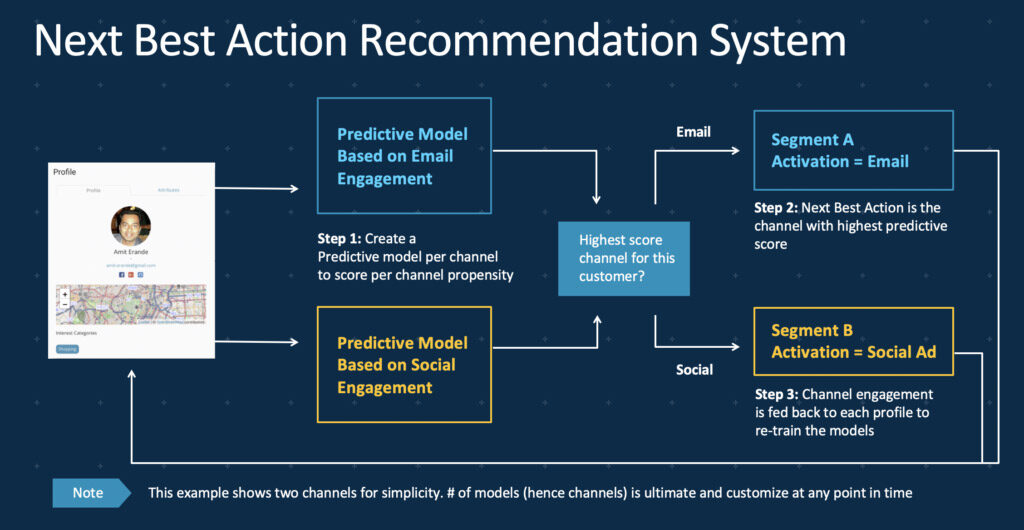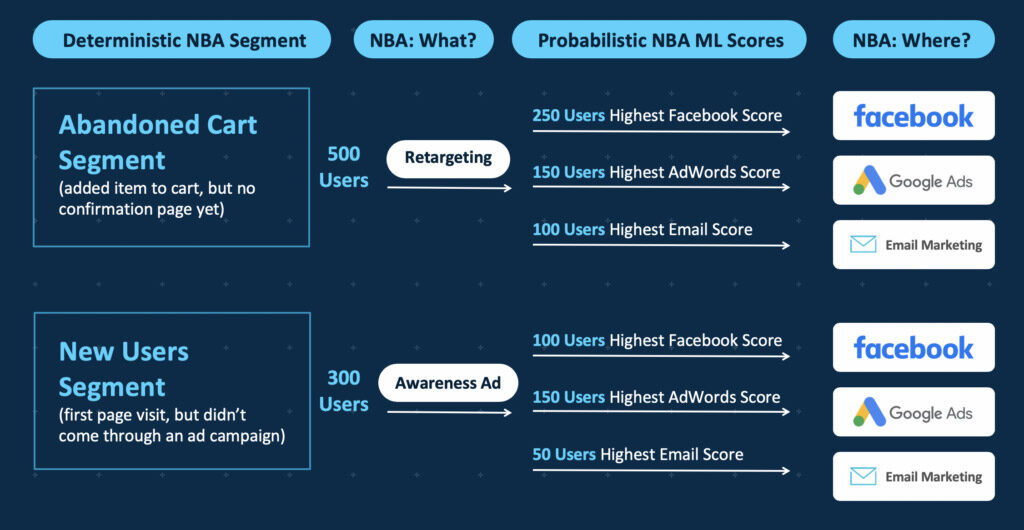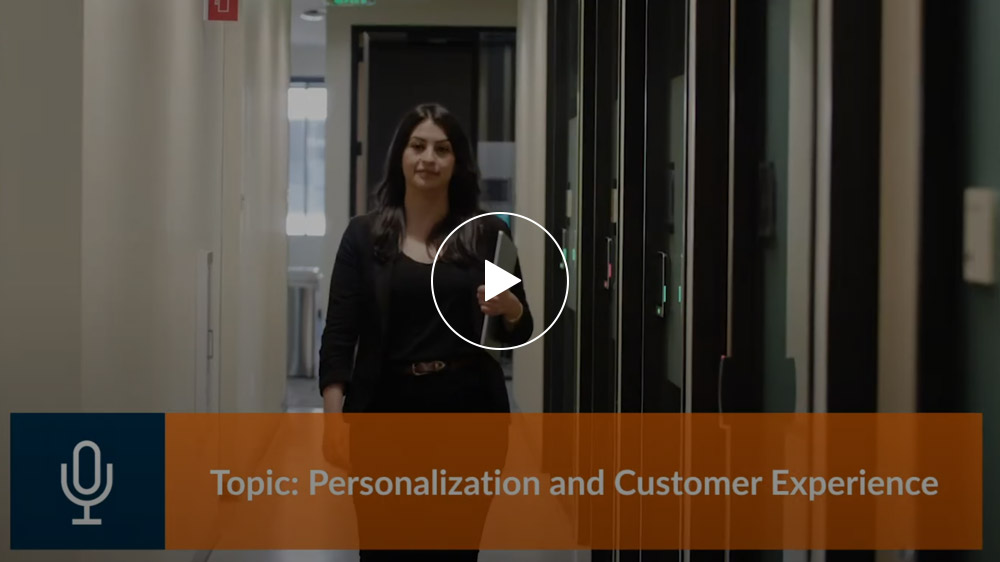Why Customer Insights Enrichment May Not Be Enough
Central to optimizing your customers’ journey is omnichannel data collection, and customer insights enrichment from second- and third-party sources takes that information a step further. But without a next best action (NBA) strategy, data alone does not help your brand seal the deal.
A next best action strategy is essential to realizing your customer data’s full potential. Customer data platforms (CDPs) can arm brands with an NBA strategy—powered by machine learning—that can change their entire gameplan. Before exploring the benefits of an NBA strategy, let’s take a closer look at customer insights enrichment and why it falls short by comparison.
Customer Insights Enrichment
Customer data gives brands valuable insight into their clients’ behavior and action. Data collection typically occurs within first-party sources, such as company websites, physical stores, and mobile apps, among others. When combined with purchase history and similar behavioral information, a customer profile begins to emerge.
Aggregating data from outside sources helps flesh out these profiles even further by adding information such as the following:

Customer insights enrichment adds muscle and flesh to the skeletal profiles built from first-party information. Marketers can use enriched customer profiles to design more effective campaigns and sales initiatives.
Why It’s Not Enough
For companies who understand the importance of customer journey optimization, data collection itself is no longer the main goal. Even with added customer insights enrichment, brands still fail to connect with customers because . . .
Not All Information Is Useful.
It hurts to hear, but it’s true. Not all data available from every touchpoint will contribute to conversion or marketing success. Pages of purchase history won’t reveal to sales reps why a customer abandons their cart. The most complete demographic profiles will not explain to customer service agents why loyal clients cancel their VIP subscriptions.
A website visitor may not express any intent to buy while browsing product pages, but they may actually be seeking a final discount to clinch their decision if they are close to conversion. Scenarios like these play out daily in countless channels and touchpoints. Without a sufficiently deep understanding of their customers, brands gain no advantage from all the available customer data.
Too Much Data Can Kill Your Process.
Companies using enrichment from second- and third-party sources must update customer profiles continually. Without timely, automated updates, brands risk the window of opportunity to act upon useful insights—especially with data stored in separate silos. Before marketing teams can devise any campaigns or outreach, IT must first clean and prepare the data for analysis. By the time it takes to implement any insights, audiences may be influenced by new factors like price hikes, an influencer vlog, or even the weather for on-site campaigns.
Even when customer insights enrichment is automated, companies can still have a hard time keeping up with data streams. It’s a classic case of “paralysis by analysis”: Too much information slows down decision-making and delays judgment. Companies need a quick way to make sense of incoming information and predict behavior to compose timely responses.
The Next Best Action Wins the Game.
There is only one way to win a game of chess: Find the winning move, time after time. Grandmasters know how much time and effort goes into honing that instinct—endless practice, tactics training, studying master games, solving puzzles. What humans can accomplish through endless hours of training, computers can do instantaneously, thanks to microprocessors that analyze millions of games and possibilities to find the next best move.
The same principle applies to customer journey optimization. Only by finding the next best action can brands and marketers hope to guide customers effectively along their journey. A next best action strategy is not only based on mountains of data, but on using that data to derive customer insights, predict behavior, and make intelligent recommendations.
CDP Fuels Next Best Action Strategy

Customer data platforms (CDPs) are key to a next best action strategy. Let’s break it down step-by-step.
Customer data platforms already excel at omnichannel data collection and customer insights enrichment. The platform unifies information to create a 360˚ customer profile. Centralizing all unified customer profiles (in CDPs) ends silos and creates a customer data foundation for IT, marketing, sales, customer support, as well as other teams.
By leveraging AI and machine learning to analyze customer behavior and discover patterns, CDPs are then able to use dynamic audience segmentation to group people with roughly similar behaviors and inclinations. This enables the platform to make more precise predictions and recreate or duplicate customer profiles.
In addition, a CDP also analyzes customer responses to marketing campaign activity. If, for example, a customer participates in a pop-up survey in exchange for freebies but gives no response to an email offer of loyalty reward points for a similar survey, a CDP can recommend when and where customers will respond positively based on past customer behavior. Individual customer profiles add high propensity scores for channels with repeated positive engagement.
Machine learning algorithms use propensity modeling to uncover insights that are often hidden from marketers. This process captures a greater range of data points correlating to desired behavior so marketers can target buyers at the right place and time.
Next Best Action…in Action
Without the intelligent recommendations rooted in the deep analysis and insight that a CDP would offer, companies can take general actions like those below:
- Target with personalized ads
- Offer product discounts
- Invite to join a loyalty program
- Send email/SMS/in-app offers
- Suggest products based on previous purchases
- Recommend products based on web searches
- Upsell services/benefits
Such generic marketing actions require a great deal of effort and resources but produce uncertain results.
Brands can go a step further and use recommender systems that trigger actions based on if-then scenarios, such as:
| IF… | THEN… |
| Customer makes first-time purchase | Offer loyalty rewards for repeat transactions |
| Customer browses high-priced item | Offer financing options, ex.: Buy now, pay later (BNPL), installment payments |
| Customer consumes longform content at brand website | Invite to subscribe to a newsletter |
| Customer searches for specific product model | Target with personalized ads |
| Customer abandons cart | Send limited time discount offer for abandoned item |
Admittedly, this is better than a blanket marketing strategy that targets everyone with the same message no matter where they are in the funnel. But rule-based recommender systems are tethered to known scenarios only, and can neither adjust to unexpected situations nor interpret nuanced behavior. Manually adding new rules and scenarios can only account for so much of the customer journey on a daily basis.
A next best action (NBA) strategy powered by machine learning uses a probabilistic model based on customer behavior and propensity for engagement with certain channels and touchpoints. This means the model learns from customer behaviors as they occur and recommends the next best action with the highest chance of success.
| Scenario | Possible Actions |
| Customer repeatedly browses product page on website but does not make a purchase | Suggest product comparisons within website |
| Offer limited time promo of 15% discount via mobile app | |
| Send email promo for referral rewards |
Advanced CDPs like Treasure Data use both models to execute precise marketing strategies. Specifically, probabilistic next best actions segments are layered on top of deterministic rules to target customers at strategic hours and channels.
As such, an intelligent NBA strategy offers the most customer-centric of all recommendations that center on customer behavior rather than company decisions alone.
Customer-Centric Messaging: Shiseido Case Study

Read the full Shiseido case study here.
USE CASES
Among surveyed organizations in the report “The State of CDPs: Data Unification, Activation and Compliance,” 40% of marketers indicated using CDPs as the next best action and recommendation engine as the top desired use case.

Brands can use an NBA strategy to transform marketing, sales, and customer service efforts into intentional encounters that aim to acquire and retain customers each time.
Marketing
Stat: 63% of surveyed companies use CDPs to personalize digital campaigns along with unifying and maintaining customer profiles.
Businesses can upend generic marketing actions and spend minimal effort and resources for maximum results. Next best action recommendation engines can hyper-personalize digital campaigns so customers engage with relevant messaging in the right channel and at the right moment.
Sales
Stat: 50% of surveyed organizations use CDPs to strengthen targeting in sales outreach and engagement
Sales can focus outreach on audience segments with a high propensity to buy instead of chasing low-propensity leads. NBA recommendation engines can also pinpoint the best touchpoints to engage quality prospects and start conversations.
Customer Service
Stat: 41% of surveyed organizations use CDPs to deliver better in-person or call-center customer service.
Instead of handing a client over to another agent, who transfers them to a superior, and so on, NBA recommendation engines can direct clients to the right agent at the beginning of their call. The platform can also aid customer service reps to avoid repeating suggested steps already taken by the client. An NBA strategy helps transactions progress through each interaction with customer support.
Make the Best Move with Treasure Data
Treasure Data’s enterprise-grade CDP enhances engagement across brand channels, company systems, and teams. Our platform uses AI and machine learning predictions to segment users and recommend the next best action at the right place and time.

Treasure Data’s next best action approach answers 3 specific questions:
WHAT
What is the next best action to guide an individual customer? For example, if a shopper adds a product but does not complete the purchase, Treasure Data’s NBA recommendation engine will suggest aggressive retargeting based on their high intent to buy.
WHERE
Where is the best channel to target a particular user? Treasure Data determines the most effective marketing channel to implement the next best action, or the “What.”

WHEN
When is the best time to target an individual customer? Our NBA recommendation engine scores customers on a daily basis to determine the best time to engage them–early morning, noon, afternoon, or night.

See Treasure Data in action:
To learn how to go beyond customer insights enrichment and unlock the full power of your customer data with a next best action strategy, consult an expert today. Request a demo, call +1.866.899.5386 or contact us for more information.
